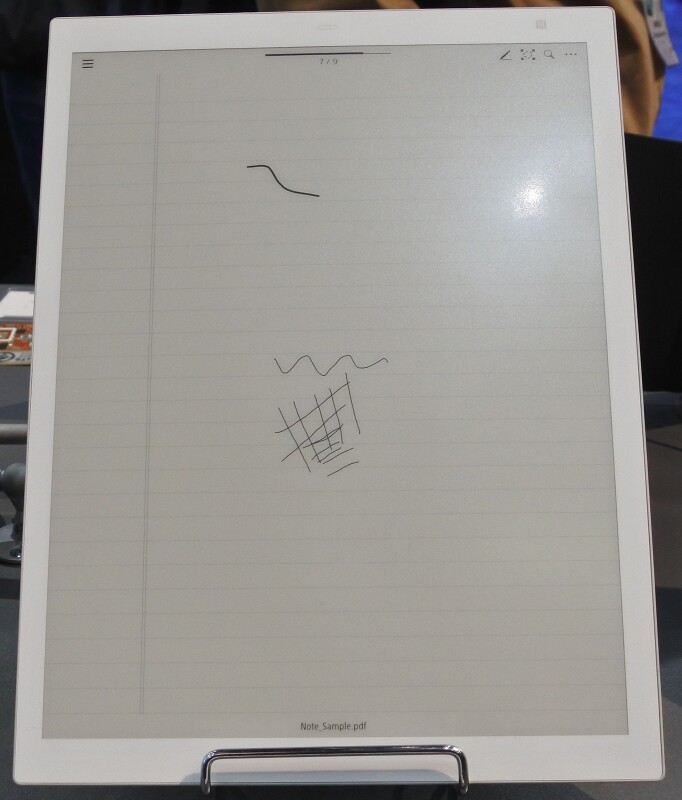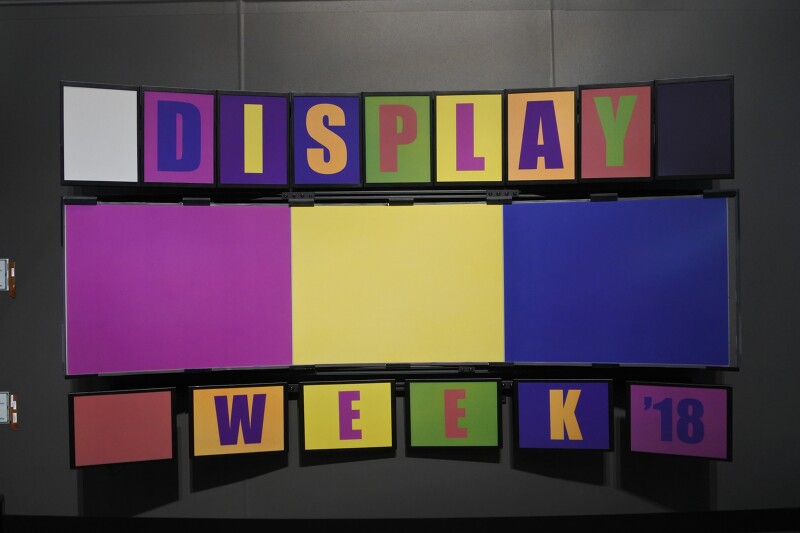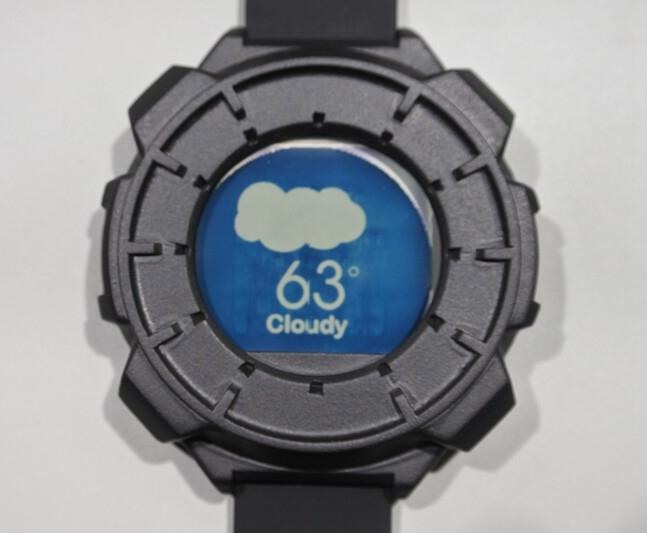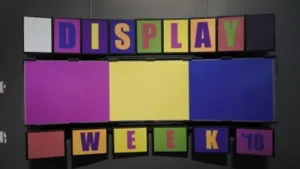Last year at Display Week, there were several start-ups showing reflective displays of one sort or another. This year, the interlopers were gone, and we were free to concentrate on was now-maturing E Ink and the feisty newcomer ClearInk.
E Ink
E Ink Chief Strategy Officer Paul Apen told Display Monitor that the company was continuing the expansion of its technologies into new markets, including eWriters, which add writing and connectivity to the core function of eReading.
Some eWriters are on the market, including the 10.3″ reMarkable Tablet with E Ink Carta imaging film, and 1872 x 1404 pixels; and the Sony E Ink Mobius with 13.3″ display and 2200 x 1650 pixels (Fig. 1). E Ink has prototypes of flexible eWriters. Apen seemed very pleased that the Chinese government has adopted 13″ eWriters for its educational system.
 Fig 1. The Sony Mobius eWriter is one of a new family of devices that add the ability to write on the screen and connectivity to an eReader. (Photo: Ken Werner)
Fig 1. The Sony Mobius eWriter is one of a new family of devices that add the ability to write on the screen and connectivity to an eReader. (Photo: Ken Werner)
Apen said they have received good feedback on the San Diego Airport project, in which E Ink Prism panels were used to create active art that brought a new parking garage to life (E Ink Used in San Diego). The good feedback is not limited to the airport authority, which was the customer, but also includes adjoining residential neighbors, who were not originally pleased at the idea of a parking garage in their neighborhood. New architectural projects are coming, said Apen.
Apen also said smart labels are doing well, and that conventional eReaders have been a significant and largely stable business. (A recent quarterly report from E Ink Holdings said the eReader market was down as dealers and customers prepared for new eReader models with larger screeens.)
And, of course, E Ink would not let us forget that it makes stunning EPD color displays without matrix color filters, even if they if they do re-address themselves in in a leisurely manner (Fig. 2). To be fair, that doesn’t matter much in the signage and information display markets where E Ink wants to sell these displays.
 Caption Fig. 2. E Ink used large areas of color to make these E Ink color displays really pop. (Photo: Ken Werner)
Caption Fig. 2. E Ink used large areas of color to make these E Ink color displays really pop. (Photo: Ken Werner)
ClearInk
The E Ink and ClearInk displays are both electrophoretic displays (EPDs), which means they work by moving charged particles through a more or less viscous fluid. In the past, this meant that EPDs could not reach video rates because it took too much time to push the charged particles through the fluid. Although E Ink has demoed moving cartoons in a screen window, commercial appliocations are largely static: eBook readers, shelf labels, signs, conference room door plaques. There many products for which such displays are just fine, but the desire persisted for a full-color, video-rate, reflective EPD.
Enter ClearInk. Two years ago ClearInk first appeared during Display Week in an off-site suite (ClearInk is a Clear Highlight of SID 2016). They had a handful of very talented people, not much money, and a very innovative idea. The idea is this. Conventional EPDs attract white or black (or, more recently) color particles to the front surface of the EPD, where ambient light reflects off the particles to impart the proper color to each pixel. As mentioned, this a relative slow process, taking on the order of 250 ms for a monochrome display.
The surface of ClearInks display is an efficient total-internal-reflection (TIR) retro-reflector. Beneath the retro-reflector is the fluid, in which are suspended only black particles. Where a particle is attracted to the back of the retro-reflector, the TIR is defeated and a black pixel appears. The contrast ratio is high, and because the charged particle moves only over a very small distance, the change from white to black is very fast. Color is obtained with a conventional matrix color filter in from of the monochrome display. This approach has produced limited color gamut and muddy colors in the past, but because ClearInk starts off with a high reflectivity, colors can look good even after the additional absorption in the filter. The company has found some enthusiastic investors over the last year, which is allowing them to devote more resources to developing the technology and working with potential customers.
In its Display Week booth, ClearInk showed a color, video-rate, reflective watch display. Director of Display Systems, Peter Kazlas, noted the significant improvements in the technology’s specifications since last year. The current watch-display prototype has a 16:1 contrast ratio, 30% NTSC color gamut, 202 dpi resolution, and 35% reflectance for white (Fig. 3). As expected with this technology, the display is sunlight-readable.
Just before Display Week, ClearInk announced the the opening of offices in Europe and China, and in the week following Display Week, the company announced it had signed a partnership agreement with a leading tablet maker to supply tablet displays beginning in 2019. The tablet displays will feature screens up to 50% larger conventional reflective tablets, high resolution, video and colour, said ClearInk CEO, Frank Christiaens. — Ken Werner
 Fig 3. ClearInk’s new prototype watch display has a 16:1 contrast ratio, 30% NTSC color gamut, 202 dpi resolution, and 35% reflectance for white (Photo: Ken Werner)
Fig 3. ClearInk’s new prototype watch display has a 16:1 contrast ratio, 30% NTSC color gamut, 202 dpi resolution, and 35% reflectance for white (Photo: Ken Werner)

